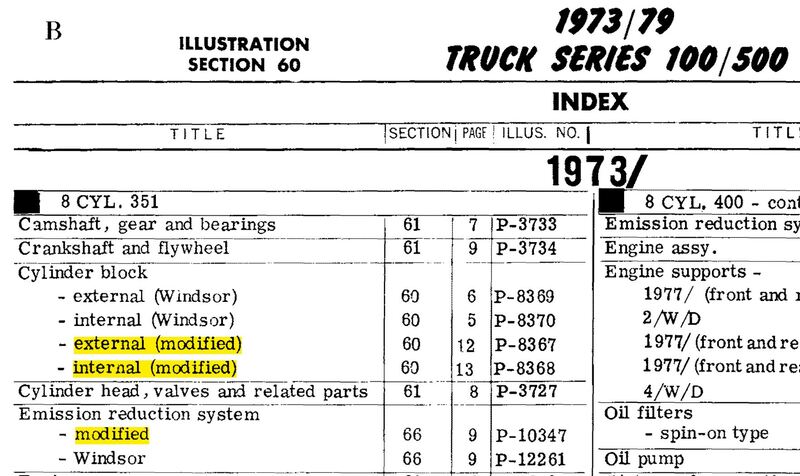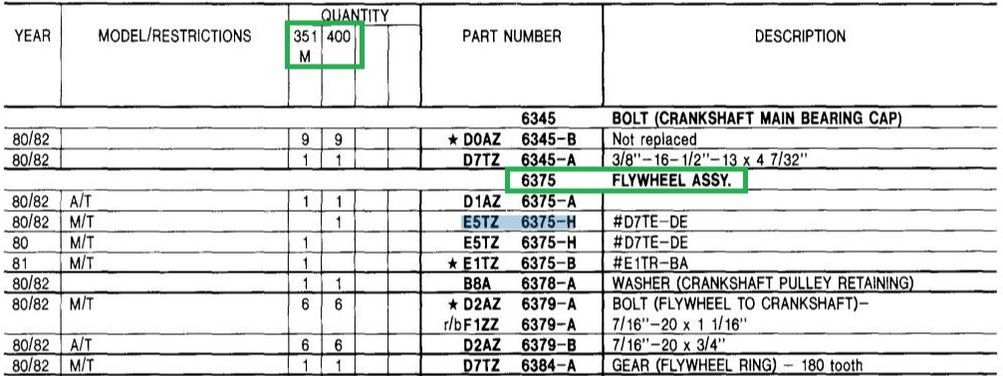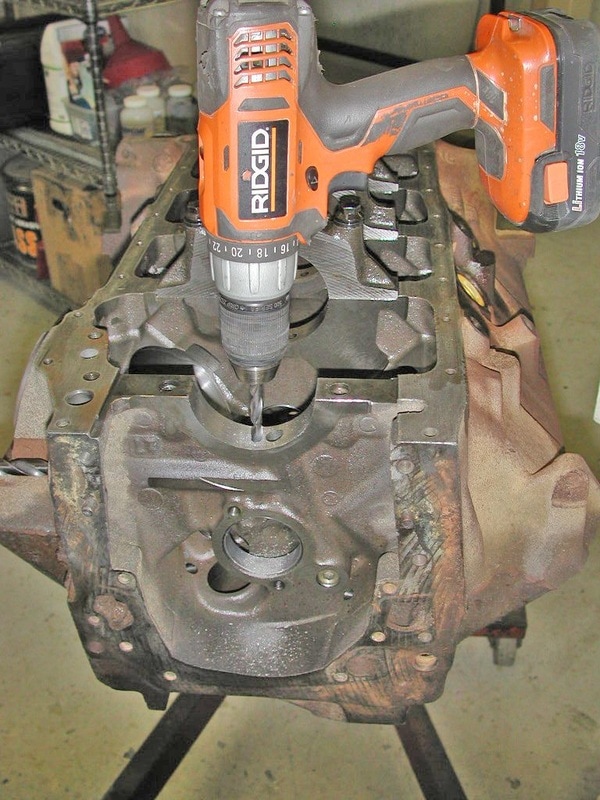351M AND 400
M-Block part numbers, illustrations, oiling system mod's, thermostats, etc
First, let's talk terminology - there is no such thing as a "400M". There are 351M's and there are 400's, but no 400M.
A little background: Ford didn't put a letter on their engines, like 351C, unless there was more than one engine with the same cubic inch displacement. So, when what we know of as the 351W was introduced in 1970 Ford had a dilemma as they already had another 351 cubic inch engine - what we know of now as the 351C. It appears that Ford decided to tack a letter suffix on to the cubic inch, and that letter was taken from the foundry where the engines were, for the most part, cast - Cleveland and Windsor.
Meanwhile they introduced the 400, which is the tall-block big brother to the 351C as both are in the 335 Series, and the taller block gave them the ability to increase the stroke from 3.5" to 4.0" to get the torque needed for the land barges and trucks. Later Ford destroked the 400 to 3.5" and that gave them a third 351 cubic inch engine - what we know of as the 351M. However, the origins of the "M" are shrouded in mystery. Some say it stands for Michigan and some say Modified, and no one seems to know for sure. But Joe Viola pointed out to me references in Ford's Master Parts Catalog which refer to the engine as a Modified. The seven I can find in any of the MPC's that cover the years those engines were used are shown below. However, I can't say that this constitutes proof that Ford officially called the 351M a Modified.
A little background: Ford didn't put a letter on their engines, like 351C, unless there was more than one engine with the same cubic inch displacement. So, when what we know of as the 351W was introduced in 1970 Ford had a dilemma as they already had another 351 cubic inch engine - what we know of now as the 351C. It appears that Ford decided to tack a letter suffix on to the cubic inch, and that letter was taken from the foundry where the engines were, for the most part, cast - Cleveland and Windsor.
Meanwhile they introduced the 400, which is the tall-block big brother to the 351C as both are in the 335 Series, and the taller block gave them the ability to increase the stroke from 3.5" to 4.0" to get the torque needed for the land barges and trucks. Later Ford destroked the 400 to 3.5" and that gave them a third 351 cubic inch engine - what we know of as the 351M. However, the origins of the "M" are shrouded in mystery. Some say it stands for Michigan and some say Modified, and no one seems to know for sure. But Joe Viola pointed out to me references in Ford's Master Parts Catalog which refer to the engine as a Modified. The seven I can find in any of the MPC's that cover the years those engines were used are shown below. However, I can't say that this constitutes proof that Ford officially called the 351M a Modified.
However, the 400 was never called a 400M as there was not another 400 cubic inch engine. But, you might ask what my source is. Easy - Ford's Master Parts Catalog. The 351's are identified as 351C's, 351W's, and 351M's in the MPC, but not so the 400. As an example of that, scroll down a bit and click on the Part Numbers tab and take a look at the extract from the MPC. Yep, it says "351M" and "400". In fact, no where in the 5047 pages of the 1980 - 89 MPC does Ford use the term "400M".
And, there are plenty of other Ford publications that use the same terminology. How 'bout the TSB on Power Valve Vacuum Hose, for one?
EDIT: On January 9th, 2019 Hot Rod published an article entitled How To Build A 351 Cleveland. See if you think they agree with my logic. 😉
Now, regarding the reputation of the 351M and 400 engines. Over the years I've heard very few good words said about them. Dad's truck had the M and it never got reasonable gas mileage, about 10 MPG, and really didn't have much power. And I think that pretty well describes the experience of many others. However, when I got Rusty I discovered that a warmed-up M can have power and better economy. That got me to wondering why the M & 400 had such a bad reputation when Rusty's engine showed that they were capable of much more.
After a lot of research, including perusing Bubba's site, reading George Reid's book on Ford 351 Cleveland Engines, and talking extensively with the Cleveland engine guru Tim Meyer, I came to realize that the main problem with the 351M & 400 is a lack of compression. They have much better-flowing cylinder heads than the Windsors. But unfortunately there's not much that can be done to raise the compression on an M as there aren't pistons available that will give much more than 8.0:1 - if that. However, Tim has pistons for a 400 that can give about any compression ratio you desire. And, all it takes to make a 351M into a 400 is a crank from a 400 and the right pistons. (Yep, the rods, heads, intake, etc are all the same for those two engines.)
Another issue with these engines is the oiling system, but Tim has a mod for that, as discussed on the Oiling System Mod's tab. So, don't be afraid to build your M or 400 up, and if you want pistons then Tim's the guy to talk to.
So, why replace your 400 with a much bigger and heavier 460? Yes, 460's have lots of torque, and they can be built up for less than a 400 since there's so much aftermarket support. But, they are heavy and guzzle gas. Why not build up an under-dog and have something different?
And, there are plenty of other Ford publications that use the same terminology. How 'bout the TSB on Power Valve Vacuum Hose, for one?
EDIT: On January 9th, 2019 Hot Rod published an article entitled How To Build A 351 Cleveland. See if you think they agree with my logic. 😉
Now, regarding the reputation of the 351M and 400 engines. Over the years I've heard very few good words said about them. Dad's truck had the M and it never got reasonable gas mileage, about 10 MPG, and really didn't have much power. And I think that pretty well describes the experience of many others. However, when I got Rusty I discovered that a warmed-up M can have power and better economy. That got me to wondering why the M & 400 had such a bad reputation when Rusty's engine showed that they were capable of much more.
After a lot of research, including perusing Bubba's site, reading George Reid's book on Ford 351 Cleveland Engines, and talking extensively with the Cleveland engine guru Tim Meyer, I came to realize that the main problem with the 351M & 400 is a lack of compression. They have much better-flowing cylinder heads than the Windsors. But unfortunately there's not much that can be done to raise the compression on an M as there aren't pistons available that will give much more than 8.0:1 - if that. However, Tim has pistons for a 400 that can give about any compression ratio you desire. And, all it takes to make a 351M into a 400 is a crank from a 400 and the right pistons. (Yep, the rods, heads, intake, etc are all the same for those two engines.)
Another issue with these engines is the oiling system, but Tim has a mod for that, as discussed on the Oiling System Mod's tab. So, don't be afraid to build your M or 400 up, and if you want pistons then Tim's the guy to talk to.
So, why replace your 400 with a much bigger and heavier 460? Yes, 460's have lots of torque, and they can be built up for less than a 400 since there's so much aftermarket support. But, they are heavy and guzzle gas. Why not build up an under-dog and have something different?
There has been some discussion about what flywheels and starters the 351M and 400 engines take. And, from the attached 1980 - 89 Ford Master Parts Catalog entries I can see why. But, Bubba's site clears that up very nicely. It says "Both 351M and 400 engines have the same 28 oz-in crankshaft imbalance, so all M-block flywheels have the same balancing counterweight, and they can be interchanged without vibration or balance problems." But, Ford muddied the water in 1985 when they issued a replacement manual transmission flywheel (E5TZ-6375-H) that is drilled for both 11" and 12" clutches - as shown on the 1989 era Master Parts Catalog captures below.
So:
So:
- Automatic transmissions: Both engines take D1AZ 6375-A flexplate, which is the same unit used in cars from 1971 forward
- Manual transmissions:
- 351M: D7TE-6375-A This is drilled for an 11" clutch, and probably used in trucks from 1977 forward given the "D7". Tim Meyer says "11 inch flywheels have 3/8" evenly spaced bolts."
- 400: D7TE-6375-B, which is drilled for a 12" clutch, and probably used in trucks from 1977 forward given the "D7". Tim says "12 inch flywheels have 5/16" bolts in 3 pairs."
These specifications are from the light truck facts book supplied to the dealers:
These are the 1980 specifications:
These are the 1981 specifications:
These are the 1980 specifications:
1981 specifications:
These are the 1982 specifications:
Ford's 335 Series engines use a bit different oiling system than most other engines, and consequently many have low oil pressure - especially at idle. In fact, both Rusty, after its rebuild, and Dad's engine, before its rebuild, had a hot-idle oil pressure of about 10 psi. Fortunately, Cleveland engine guru Tim Meyers has a solution for that.
This diagram of Tim's shows what the original flow was like and what needs to be done to fix it:
This diagram of Tim's shows what the original flow was like and what needs to be done to fix it:
In words:
If you are like me and want to see how what you are doing fits into the overall oiling system picture, here's my rendition:
- Drill the feed from #1 main toward the passenger's side gallery out to 7/16", tap it 1/4" NPT, and insert a plug
- Drill the passage from #1 main toward, but not to, the cam bearing out to 5/16"
- Install Tim's special cam bearings according to the directions that come with them.
If you are like me and want to see how what you are doing fits into the overall oiling system picture, here's my rendition:
Here's the pipe plug after I drilled and tapped the #1 main in Dad's engine:
And here's a picture of me drilling out the passage going toward (not to!) the cam bearings:
But, if you are like me and can't let "well enough" alone, then I believe there are a couple more things that can easily be done to help the engine's elixir of life flow. First up is to modify the oil filter adapter. Here's a picture of three of them, with a new one on the right, the one I pulled out of Dad's engine in the middle and sporting dings from the Vise Grips (red arrow), and the modified one on the left. Since this is the view the oil flowing out of the filter will see, a little bit of rounding of the opening will allow the oil to flow more easily.
Then there's the nasty corner below (above in reality) the adapter which the oil has to get past. In my estimation this is going to cause turbulence and impede the flow.
So, I blended that edge like this. And, as you can see, I also blended the incoming hole so the oil can more easily make that transition.
So, does it work? Well, I sent the engine to Tim for him to assemble and haven't gotten it back yet. But, I did go up and watch it run on his dyno, and the mod's certainly work. After several minutes warming up and 6 pulls on the dyno, where it showed 500 ft-lbs, the idle oil pressure was 20 psi. In other words, the mod's work quite well.
|
The 335 series engines are a bit unusual in that they don't have the typical external bypass hose that moves coolant through the block when the thermostat is closed. Instead they have an internal bypass system that provides the same function, and it has the advantage of not having a hose that can go bad.
But, it requires a different thermostat than other Ford engines. How do I know this? On the right there's a snippet from Ford's Master Parts Catalog. If you click on it you'll get a bigger picture where you can see that the 351M/400 takes a different thermostat than the other V8's - an RT-139. |
So, what is an RT-139 and why is it different? In the pic on the left, below, (thanks, FilthyBeast), you can see that it has a "skirt" or "bell" on the bottom. That's because it is a "bottom-bypass" thermostat, and that skirt blocks the hole you can see in the engine, thereby stopping the flow of coolant into the block that is bypassing the radiator. And in the pic on the right you can see the bypass thermostat compared to a standard thermostat.
The whole process of thermostat opening and coolant bypass is well-described on this ARE page, but here's Reader's Digest version:
- Cold Engine: The skirt is up, as in the pic, and the thermostat is closed so the coolant cannot go to the radiator. Instead it goes through that hole to the engine, bypassing the radiator.
- Warm Engine: The thermostat opens and the skirt drops down into that hole. So coolant flows to the radiator and is blocked from going directly back to the engine.
However, many people don't know about the bypass and don't use the special thermostat. By my calculations that means they'll be recirculating over 10% of the coolant back into the block without sending it through the radiator. In other words, that immediately reduces the cooling capacity of the system by at least 10%.
So, you might ask what thermostats are correct for these engines. The list isn't all that long, but here are the ones I know of:
Now, if you really like to research things, here are just four of the threads on FTE that discuss thermostats in more detail. (But wait, there's more!)
So, you might ask what thermostats are correct for these engines. The list isn't all that long, but here are the ones I know of:
- Track Boss: Tim Meyer is having the original high-flow Robert-Shaw thermostats for the 335-Series engines made again. At one time those 'stats were the sought-after ones for the 335 Series engines. But, unfortunately they've been out of production for a number of years. According to the salesman with Caltherm: "Robert Shaw Thermostats were bought out by Copper Standard. We (Caltherm) since then have bought out Copper Standard. So the short answer for you is Caltherm currently makes the Robert Shaw Thermostats". However, that was just for the basic Robert Shaw thermostats, not the special ones for the 335 engines. But, Tim Meyer says "The reason the Cleveland-correct thermostat was discontinued originally was the tool that makes the "hat" broke, and they chose not to repair it. So we paid to have the tool replaced, and that is how the Track Boss thermostat is the old Robert-Shaw thermostat." Once again Tim proves to be The Man when it comes to the 335 Series engines.
- Motorcraft RT-139: This one is said to obsolete but they do turn up from time to time
- Robert-Shaw 333-195: This was a high-flow thermostat and was the preferred one for many people. However, it is no longer available. (See TMeyer, above.) But, if you have an old one you can pull the bell off of it and place it on their 303-195 as that seems to be the only difference.
- Gates 33129
- Napa 297
- Stant 13469
Now, if you really like to research things, here are just four of the threads on FTE that discuss thermostats in more detail. (But wait, there's more!)
- The Dreaded 351M/400 Thermostat Question (1973 - 79 FTE forum)
- Special Thermostats (335 Series FTE forum)
- Really Hate Asking This Question (1973 - 79 FTE forum)
- Dads Engine (1980 - 86 FTE forum)
- TMeyer Opinion On Thermostats (335 Series FTE forum)
This section is from Ford's 1981 factory service manual:



















